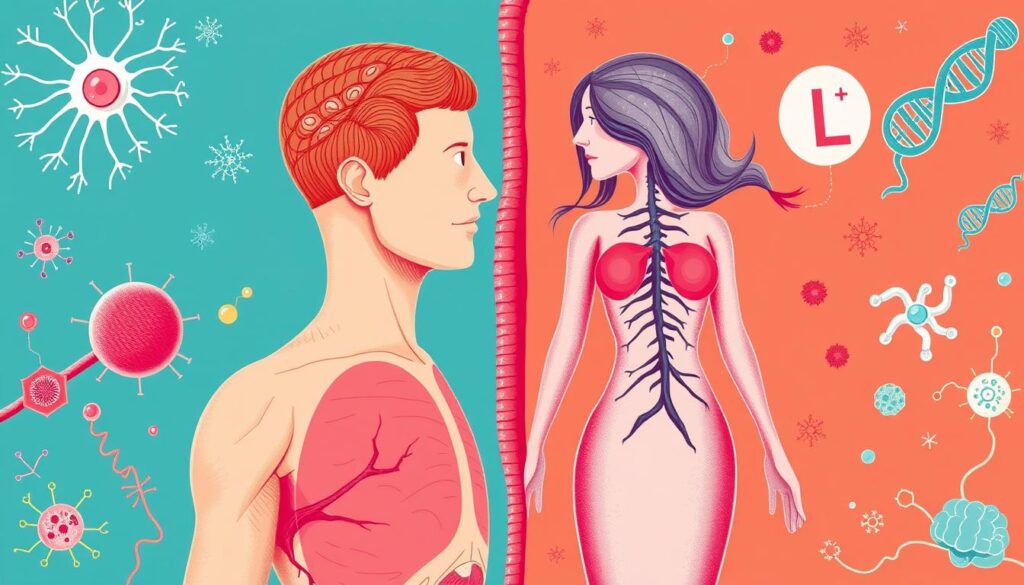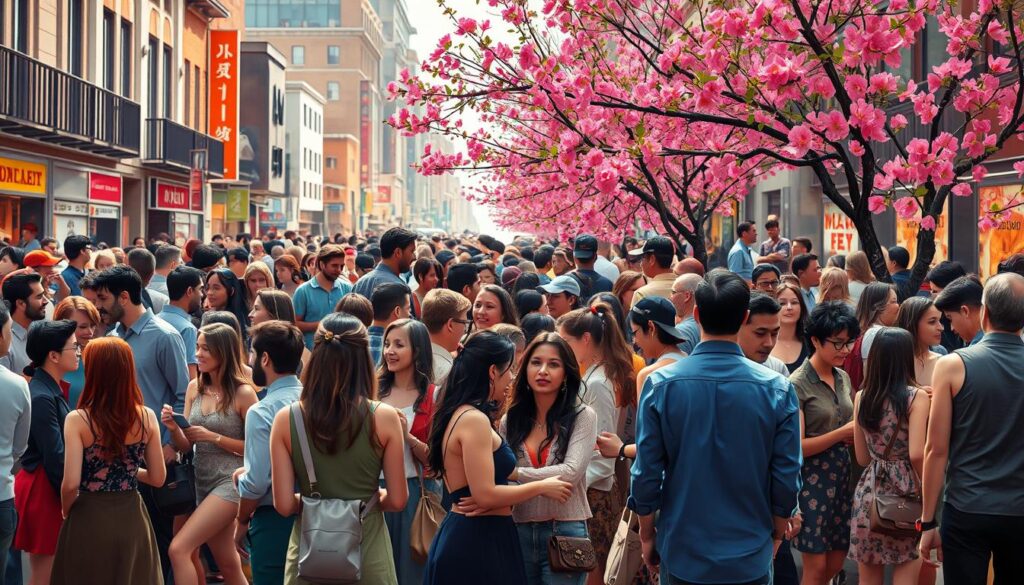Is there a difference in Do Males and Females Have the Same Libido?? This question is intriguing and worth exploring. Libido varies due to many factors, including biology, psychology, and society. Studies show clear differences in sexual desire between the sexes.
This highlights the need for a detailed comparison of libido. By looking into these differences, we can understand how hormones, social norms, and personal connections affect sexual desire in both men and women.
Understanding Libido: An Overview
Libido is key to sexual health and involves many factors that shape our sexual desire. It’s about our drive for sex, influenced by both our body and mind. This mix makes our sexual desire complex.
Many things affect our libido. Hormones, mental health, and stress can change how we feel about sex. Also, what society thinks about sex impacts our views and actions. Studies, like those from the American Psychological Association, show that gender differences in libido are not as simple as we think.
To truly understand libido, we need to look at everything that affects our sexual desire. Our mood, past experiences, and physical health all play a part. Seeing these aspects helps us understand sexual health better and why libido can vary from person to person.

The Biological Basis of Libido
The biological factors of libido are key to understanding sexual desire. They show how libido differs between men and women. Studies reveal brain responses to sex show clear gender differences. This research uses neuroimaging to explore libido and sex drive, shedding light on each gender’s unique arousal patterns.
Hormones like testosterone and estrogen greatly affect libido in both men and women. For example, testosterone boosts sexual desire in men. In women, estrogen’s impact on libido changes throughout their menstrual cycle. These hormones work with brain pathways to shape desire. Many studies, found in reliable academic articles, delve into how hormones influence sexual desire.

Exploring the complex biological factors of libido helps us understand individual sexual behaviors and preferences. As research continues, it’s vital to keep studying the biology of sexual desire. This knowledge is crucial for sexual health and relationships.
Social and Environmental Influences on Libido
Libido and society are closely linked, affecting sexual desire in many ways. Social influences on libido shape how we see and act on our sexual needs. Cultural norms, for instance, set what’s okay and what’s not when it comes to sex.
Media’s portrayal of intimacy can either boost or lower our sexual desire. This shows how society’s views on sex can impact us.
Our surroundings greatly influence our sexual experiences. Things like our relationships, job stress, and family duties can change how much we desire sex. Many people notice their libido changes when their environment does.
Studies show that changes in society’s values often match changes in libido levels. You can learn more about this here.
Getting how environment and libido interact is key to understanding sexual desire. Seeing how social norms affect our feelings of closeness helps us understand modern relationships better.

Do Males and Females Have the Same Libido?
Looking into male vs female libido shows interesting differences in sexual desire. Research shows clear differences in libido levels and how often people think about sex. These sexual desire gender differences help us understand human behavior better.
Exploring Gender Differences in Sexual Desire
Studies reveal that males usually have a higher libido than females. Males often have more sexual thoughts and desires. This suggests a biological reason for these differences, affecting how they approach sex and relationships.
Cultural Perspectives on Libido
Culture greatly influences how we see and express our sexual desires. For example, in some cultures, being male is linked to high sex drive, seen as a sign of masculinity. On the other hand, female sexuality might be viewed differently. This shows how cultural influences on libido lead to varied sexual behaviors. The Kinsey Institute’s research shows that societal norms are key in shaping libido views across genders.
The Role of Hormones in Libido
Hormones are key in shaping libido for both men and women. The main hormones linked to effect of hormones on sexual desire are testosterone, estrogen, and progesterone. In men, testosterone drives libido, affecting sexual health and desire.
In women, estrogen and progesterone are vital for sexual desire. These hormones control many body functions and greatly affect hormonal influence on libido. For example, hormonal shifts during the menstrual cycle can change sexual interest. Studies show that high estrogen levels can boost sexual desire, while low levels can decrease it.
Age also plays a role in hormonal changes and libido. During puberty, testosterone and estrogen levels surge, boosting sexual interest. But in middle age, hormone levels drop, often changing sexual desire and behavior.
Knowing how hormones and libido are connected helps us understand why some people feel more desire at certain times. It also shows why others might struggle. This knowledge is crucial for understanding sexual health.
Psychological Factors Affecting Libido
The way our mind affects our libido is very important. Stress, anxiety, and depression can really change how we feel about sex. When we’re stressed, we often don’t feel like being intimate.
Being in a good relationship also matters a lot. When we feel loved and supported, we might want sex more. But if we’re not happy or feel insecure, our desire for sex can drop.
Studies by the American Psychological Association show that our mind plays a big role in our sex life. For more info, check out these studies on sex and the mind. Understanding these factors can make our relationships and sex lives better.
Age and Libido: How They Interact
As we age, the connection between age and libido becomes more complex. Understanding how libido changes over time helps us see how sexual desire evolves. This evolution is shaped by many biological and psychological factors.
Libido Changes Over Time
Libido changes due to aging, hormonal shifts, and personal experiences. Many notice a drop in sexual interest as they get older. This can be due to hormone changes, health issues, or life events.
Knowing these patterns can help manage expectations. It also helps in seeking support when needed.
Midlife and Sexual Desire Shifts
Midlife is a key time for exploring libido. Changes in libido during this period differ for men and women. Factors like career stress, parenting, and relationship issues can impact sexual desire.
Understanding these challenges can help partners connect better. It fosters communication and closeness.
Comparative Studies on Male and Female Libido
Research into libido shows big differences in sexual desire between men and women. Many studies point out that these differences come from biology, society, and psychology. For example, testosterone is key for male libido, while estrogen affects female desire.
Studies show that male libido peaks in adolescence, leading to more sexual thoughts and actions. Women’s sexual desire changes with their menstrual cycle, relationship status, and emotions. These findings help us understand how gender affects libido and why context matters.
Qualitative studies show that social norms shape how we express libido. Women might feel pressured to hide their desires, while men are encouraged to show theirs. This cultural influence can affect how accurate self-reported data is.
Researchers keep studying these differences, and studies in the Archives of Sexual Behavior are very helpful. They show both the similarities and differences in sexual desire between men and women.
How Relationships Impact Libido
Relationships greatly affect libido, shaping how we feel about sex. Emotional closeness and talking openly are key to a healthy libido in partnerships. When we share our needs and feelings, our intimacy and libido grow stronger.
But, unhealthy relationships can stress us out and lower our libido. Conflicts and poor communication block intimacy, reducing our desire for sex. Studies show that happy relationships boost our sexual health, showing that strong bonds lead to higher libido.
To boost intimacy and libido, couples should talk about their emotional needs often. Building trust and feeling secure in a relationship helps create a fulfilling sex life for both. Looking into the many sides of relationships helps us understand how libido changes with our partners.
Health Conditions and Their Effect on Libido
Many health issues can lower sexual desire and health. Conditions like diabetes and heart disease can do this. They change hormone levels, reduce energy, and cause emotional problems, all affecting sex drive.
Mental health is also key. Anxiety and depression can make sex less appealing. Getting help for these can boost libido by improving overall health. The Mayo Clinic and World Health Organization say seeking therapy or medication is important.
Some treatments, like chemotherapy or hormonal therapy, can also impact sex drive. Knowing how health issues affect libido can help people get the right care. This can improve sex life and relationships.
Improving Libido: Tips for Both Genders
Boosting libido is a journey of self-discovery and growth. Many look for ways to increase sexual desire and improve overall well-being. Making lifestyle changes and improving communication can greatly enhance sexual desire for both men and women.
- Maintain a balanced diet: Eating a variety of fruits, vegetables, lean proteins, and whole grains boosts energy and mood.
- Stay physically active: Regular exercise improves blood flow and can positively affect libido.
- Focus on mental health: Managing stress, anxiety, or depression is key to maintaining healthy sexual desire.
- Enhance emotional intimacy: Building trust through open communication with a partner can greatly improve sexual experiences.
- Consider medical advice: Getting advice from healthcare professionals can help those struggling with libido issues.
Understanding the connection between physical and emotional factors is crucial for boosting libido. By focusing on healthy living and understanding personal needs, individuals can create a better environment for stronger sexual desire.
Future Research Directions in Libido Studies
Looking ahead, libido research is set to evolve. It will focus more on how age, gender, culture, and technology affect our desires. We’re seeing new trends where digital platforms might change how we connect and express our sexual interests.
Researchers are also working to include more diverse groups in their studies. This will help us understand libido better and fill gaps in current research. They aim to study how changes in society impact libido in different populations.
There’s a growing need to study the psychological and environmental factors that influence libido. New methods and analysis frameworks are being developed. This will help us better understand libido and improve health policies related to sexual well-being.






